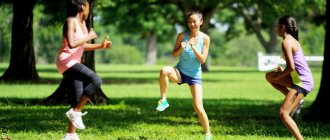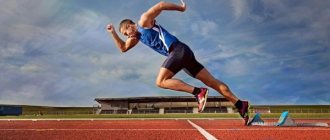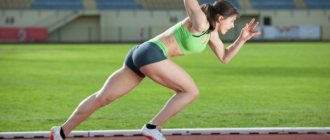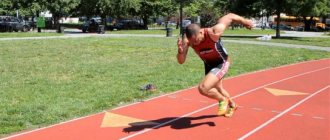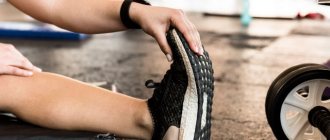Do these exercises. Get better at sprinting. Run faster. Why sprint? Because running has a strong impact on your overall fitness. Faster athletes are better athletes. Even if you're not into athletics, running is still extremely important. If you want to achieve truly incredible speeds, you will need to make conscious exercise choices for your gym program.
Here's what will make you faster:
What is a sprint and who is a sprinter?
Sprint is running with maximum acceleration over short distances, from 50 meters. Sprinting looks bright and spectacular, with pronounced power activity of the whole body. During a sprint, a runner works to the limit.
All processes in terms of physiology and biochemistry are launched at full capacity. When sprinting, the muscles of the athlete’s entire body, including the myocardium, are maximally activated, the respiratory system is mobilized, and the load on the ligaments increases. A sprinter is an athlete who runs and swims short distances.
Pre-competition preparation of a sprinter[edit | edit code]
Let's start with the fact that you need to identify in advance, for yourself, the main and intermediate starts. Personally, I prefer to classify starts (Basic, necessary, intermediate). As a rule, in a season there is 1 main start, 2-4 necessary ones and 3-6 intermediate ones.
Pre-competition preparation takes about 10 days; naturally, you won’t be able to prepare for every competition, and in principle this is not necessary. Actually, the point is to correctly distribute pre-competition preparation in order to reach the “peak” in the main competitions. What does it look like?
To begin with, let’s denote the starts with numbers:
- 1 - Intermediate
- 2 - Necessary
- 3 - Main
For example, in the season we have 8 starts and 1 start is exactly the main one, for which we will actually prepare, and we must classify other starts by importance, it will look something like this: 1,1,2,1,1,2, 1.3
What's the point?
For the central nervous system, any start is stressful, it works to the limit, and it needs to rest, and if we take into account that we will use various stimulants, then in this case we need to rest even more. This classification of starts will give you that notorious supercompensation and will take you to maximum performance for the main competition.
Let's move on to some points:
- 1 - at least 15 days must pass between the 2 “necessary/main” starts;
- 2 - after each “necessary” start you need to rest well;
- 3 - pre-competition preparation should be carried out only before the necessary and main starts.
Well, the pre-competition preparation itself:
- 10 days L-thyroxine - 50 mcg (in the morning)
- 10 days before bedtime melatonin + sedative, do not take sedative the day before the start.
- 7 days, finish 3 days before the start - ideally no carbohydrates, but at least limit carbohydrates.
- 2-3 days before the start carbohydrates without restrictions
- 1-2 hours before the start Triiodothyronine - 50 mcg
- 1-2 hours before the start CNS stimulant (for example Ladasten)
- Don't forget about water, about 4 liters per day.
Regarding training:
- We train according to plan for 7 days
- 3 days before the competition: Good warm-up/stretching
- type of training according to plan but with much less volume and less intensity, for example: 1 day running - 1x10, 1x30, 1x60 80%, 1x150 50% + stretching
- Day 2 strength – weight 60% 2x4 + cool-down + stretching
- the day before the competition - Good warm-up/stretching + 1x150 70%
Features of sprint running
Sprint running has differences from other running styles.
The characteristic features of a sprint are as follows:
- a powerful push is performed;
- hips rise high;
- the foot falls to the surface rigidly;
- anaerobic respiration;
- special breathing skills;
- high level of energy and power costs.
Sprinting requires excellent fitness, discipline and proper training.
Features of training in sprint running
Before moving directly to the sprint, runners will have to undergo special training. Experienced trainers recommend starting with medium distances and then moving on to short distances.
Preparation stages:
- General endurance training: aerobic capacity, biomechanical and mental capabilities - steady running without a break from half an hour to 3 hours.
- Strength endurance: overcoming strength stress for a specific time, for example, when performing strength exercises with a short rest break.
- Development of speed stability: maintaining running speed - interval accelerations.
- Special endurance: fatigue resistance – tempo running;
- Long-term progress: improving running technique.
The transition to the high-speed part occurs gradually, with a consistent increase in load. To control the technique, first run at ½ the maximum intensity, then at 3/4 intensity.
The main elements of sprinting technique include a low start, powerful acceleration after the start, running in a straight line and around a turn, finish - shoulder throw to the finish line, training in running technique in general.
Running technique is taught at low intensity of movement and at a uniform pace. Then they move on to running with acceleration, with a maximum increase in speed indicators. Exit from the start is also trained separately.
When preparing for sprint running, the emphasis is on general and special exercises. Most often during training you have to:
- run with high hips, raking legs and energetic movements of bent arms;
- running with shin sprains;
- run and mince in small steps;
- jump sideways;
- jump, pushing off completely from your feet, from foot to foot;
- overcome obstacles with a running start;
- step over the barrier back and forth;
- step sideways over obstacles;
- do a “bicycle” in a lying position;
- run in place, raising your hips high;
- work with your hands at different frequencies, while your elbows do not need to be spread to the sides.
Sprint stages[edit | edit code]
The sprint distance is conventionally divided into four stages, each of which has its own technical characteristics. These stages are the start, starting acceleration, direct running along the distance and finishing.
To start
in smooth running, a low start from the blocks is usually used - this method allows you to achieve maximum effect at the next stage. For such a start, blocks are used - special sports devices, by resting on which, you can more easily maintain stability in a position for a low start, and start effectively and quickly. Resting against the blocks, the runner rests on his hands and waits for the signal to start, avoiding excessive muscle tension, while being in constant readiness to instantly take off.
Second stage - starting acceleration
. Usually this is the first 15-20 meters of the distance. The athlete’s main task at this stage is to achieve maximum running speed as quickly as possible. After the start, the athlete’s torso rises to a tilt of 15-20 degrees from the vertical, and the amplitude of the step increases. Excessive leaning reduces running speed and creates a risk of falling.
The third stage is distance running.
At this stage, it is important to maintain the speed gained during acceleration for as long as possible. The tilt of the body is reduced to 10-15 degrees from the vertical; when pushing off, the athlete’s shoulders are pulled back somewhat. In the phases between the contacts of the legs with the support, the body tilt increases slightly.
The last stage of the sprint is finishing.
The task of finishing is to continue to maintain it at a high level, despite the natural decrease in speed. To maintain speed, the athlete increases the step frequency, for which he increases the intensity of arm movements. Finishing ends with reaching the final line and the subsequent gradual stop of movement.
Sprint running shoes
The right training shoes are the key to success. For sprinting, you need sneakers with soft textured studded soles for better traction on the surface. This sole reduces fatigue of the foot and allows it to be fixed more firmly.
Characteristics of running shoes for sprinting:
- Rigid fixation of the foot.
- A light weight.
- Comfort
- High-quality adhesion to the surface.
Before starting, you should check the lacing to ensure that an untied lace does not cause injury or reduce speed. Poorly fitting sneakers on your feet create discomfort when moving, which can seriously affect your speed.
Spikes for sprinting: description, selection criteria, best manufacturers
Ranks in sprint running
To receive a rank, you must pass the appropriate standards provided for each category of athletes. In addition to the time and distance criteria for assigning a sports category or title, you must adhere to the rules of the judging panel.
When passing the standards, for example, three judges of category I must be present on the panel of judges. Timing, which can be manual or automatic (electronic), is crucial. Nowadays, the electronic version is most often used in competitions.
There are also qualifying starts for championships or competitions to obtain ranks. They are usually held in athletics sections and are an incentive for achieving certain results through systematic preparation.
Table of rank standards for stadium running for men
Table of rank standards for women's stadium running
Beginners. Start: 13,000 ₽
You can start athletics at any age, but those who start at the age of 11-12 have more prospects. Basic things will be enough to start going to training. At the start, this will be a warm-up, special running exercises and the main part of the lesson: for example, segments or general physical training.
A young athlete needs such a starter kit. Prices for adults may vary slightly:
| Children's tracksuit | 1500 – 4000 ₽ |
| Sneakers | 1000 – 4000 ₽ |
| Warm winter clothes | 1500 – 3000 ₽ |
| Backpack | 1000 – 2000 ₽ |
Later, when there is a division into events (short distance, middle distance, long jump, javelin throw and others), the sprinter will need spikes - they cost from 2000 rubles. You need to choose them for a specific distance.
The goal of running shoes with spikes on the sole is to maximize push-off efficiency by minimizing ground contact and traction.
There are three types of studs according to their purpose:
- for medium and long distances;
- for sprint;
- for rough terrain. You can purchase them in addition to your workouts.
The athlete can decide for himself which event to choose, or a coach will help him with this - he will evaluate the performance, capabilities and development prospects.
“Athletics is generally an inexpensive sport, one of the least expensive. When I first came to the sport, it was in the late 90s, my family didn’t have much money,” recalls sprinter Natalya Pogrebnyak, European champion and participant in three Olympics. She competed for Ukraine, and now lives and trains in Krasnodar and runs for Russia. – The first spikes cost $50 and were a great joy, because before that I had to train in regular sneakers. Later, other things were needed: a uniform, sneakers and a backpack.”
A separate item is the cost of classes. You can train at a sports school or section where training is free. Another thing is training in small groups in stadiums and arenas.
The trainer is usually a professional who has the rank of Master of Sports, Master of Sports and special education. The cost of such classes starts from 400 rubles in the regions and from 800 rubles in the capital. Personal lessons with a trainer are two and sometimes three times more expensive. The trainings are paid because they are conducted by professional athletes who do not work in public schools. We can say that they work for themselves and help others improve their running performance for a monetary fee.
Plus, you need to remember that the entrance to some stadiums and arenas is paid (applies to large cities, like Moscow and St. Petersburg) - from 200 rubles.
At any stage of preparation, athletes need to recover. The more serious your approach to sports, the more important post-workout activities are.
It is advisable for sprinters to have a massage; without it, the muscle tissue becomes overstrained, and this leads to frequent injuries. A massage of one area, on average, costs 400 rubles, if you cover a larger area - 1000 rubles. You need to do a massage taking into account the specifics of the training regime and the pace of preparation for competitions.
Total:
total start-up costs are no more than 20,000 rubles. You can cut costs by two to two and a half times if you save on equipment and study for free at a sports school.
| Summer things | 4000 ₽ |
| Sneakers | 4500 ₽ |
| Winter clothes | 5000 ₽ |
| Accessories | 2000 ₽ |
| Sprint spikes | 5000 ₽ |
Records in sprint running
Records serve as an example of the development of outstanding abilities and an indicator of motivation to achieve higher results. All over the world, women's and men's records are usually separated due to the difference in physical indicators. Kenyan athletes set the most running records. Commentators joke that Kenyans are helped by lions moving freely on the roads.
Men's world records:
- 1972 – 100 m and 200 m – Valery Borzov (USSR) – 10.14;
- 1980 – 400 m – Viktor Markin (USSR) – 44.60;
- 08/06/1992 – 400 m hurdles – Kevin Young (USA) - 46.78;
- February 9, 1996 - 60 m - Bailey Donovan (Canada) - 5.56;
- 08/16/2009 – 100 m – Usain Bolt (Jamaica) – 9.58;
- 08/20/2009 – 200 m – Usain Bolt (Jamaica) – 19.19;
- 09/07/2021 – 110 m hurdles – Aris Merritt (USA) – 12.80;
- 08/14/2016 – 400m – Weide Van Niekerk (South Africa) – 43.03;
- 01/20/2018 – 60 m – Christian Coleman (USA) -6.37.
Usain Bolt (Jamaica) is the only athlete who managed to win the 100 and 200 meter sprint distances at three Olympics in a row. He received the nickname "Lightning" for his speed.
10 best sprinters on the planet: biography and history of development
Among women, two athletes have the largest number of records at once: Florence Griffith-Joyner (USA) and Tegla Lorupe (Kenya). Each has three historical results.
Entered the world record history (women):
- 1980 – 100 m – Lyudmila Kondratyeva (USSR) – 10.87;
- 1982 –400 m –400 m – Jarmila Kratokhvilova (Czechoslovakia) – 49.59 seconds;
- 1985 – 400 m – Marita Koch (Germany) – 47.60;
- 1987 – 400 m – Olga Bryzgina (USSR) – gold medal;
- 1988 – 200 m – Florence Griffith-Joyner (USA) – 21.34 seconds;
- 1988 – 100 m – Florence Griffith-Joyner (USA) – 10.49;
- 1992 – 400 m relay race – Olga Bryzgina (USSR) – gold medal;
- 1993 – 60 m – Irina Privalova (Russia) – 6.92;
- 1995 – 50 m – Irina Privalova (Russia) – 5.96;
- 1996 – 400 m – Marie-Josée Perec (France) – 48.25;
- 2003 – 400 m hurdles – Yulia Pechenkina (Russia) – 52.34;
- 2016 – 100 m hurdles – Kendra Harrison (USA) – 12.20.
Paralympians can also run. Paraathlete Oscar Pistorius, who ran the 400m in under 47 seconds while wearing artificial limbs on both legs below the knees.
Interesting! According to the rules of sprint running, if the maximum tailwind speed at a competition is more than 2 m/s, the final result is not recorded for the athletes as a personal record.
Trips to competitions paid out of pocket
It is common practice for an athlete to travel independently, for example, to the Russian Championship. Then you pay for travel, food, and accommodation out of your own pocket. On average 15,000 rubles.
Much depends on the sprinter’s capabilities and desire to achieve results in competitions. It happens that after two or three unsuccessful performances, the guys stop going to tournaments and continue to run for fun in their region or region.
Due to the developed infrastructure in Moscow, St. Petersburg and the Moscow region, competition among sprinters has increased significantly. Four athletes from Moscow took part in the men’s 200-meter final at the Russian Cup, which took place in August in Bryansk.
The trend of increased competition can also be seen in relay running. At the Russian indoor championship among juniors and juniors under 23 (February 13-15, 2022), the team from St. Petersburg won the men’s 4x400 relay, and the Moscow region came second. During the relay, the sprinters are really one team, but in their own region they are fierce competitors.
However, the decision of many sprinters to move to Moscow or St. Petersburg does not always have a positive effect on the quality of training and improvement of performance, because there are good coaches in small cities of Russia. Rather, the status of the runner changes, especially if he begins to compete for the national team.
It should be noted that the difference in cash spending in the regions and in Moscow or St. Petersburg is minimal. But in Moscow and the region, the level of wages is higher, and, going back, there is high competition and a small probability that in a short time you will be able to “shoot” and get into prizes at the championship of the city or region.
Total: to overcome the transitional stage - about a year or two, you need to lay down about 25,000 rubles. You don’t need to buy uniforms and sneakers so often, but without recovery and sports nutrition, it’s not always possible to show the desired results.
The benefits of sprinting
Sprint running can be used not only as a competitive athletics discipline in preparation for the Olympic Games, but also as a mandatory component of training, both professional and amateur. Many people engage in sprinting not for the sake of sporting victories, but solely for their own pleasure. The short-distance running technique has a beneficial effect on the human body:
- Increased endurance.
- Dexterity of movement.
- Development of coordination of movements and sense of balance.
- Improving the efficiency of the respiratory system.
- Improved blood circulation, more oxygen enters the blood.
- Increased muscle tone.
- Strengthening the muscular frame.
- Acceleration of metabolism and energy.
- Subcutaneous fat is actively burned.
- Weight correction in a weight loss program.
- Increasing the level of adaptation to physical activity.
- Strengthening the cardiovascular system.
Think about muscle length when lifting weights
The main muscles that are used during sprinting alternately lengthen and contract. Choose weight lifting exercises that have the same effect (long vs. short).
The hip joint straightens the leg down and back to allow movement of the body. The main muscles responsible for this movement are the glutes and the two-joint hamstrings. The term "biarticular" refers to three of the four hamstring muscles that move like the hip joint and knee joint.
When the foot hits the ground, the knee is almost completely aligned and the leg is directly or slightly ahead of the body's center of gravity. In this position, the tendons work over a fairly large length of the muscle, and from there they will not only extend the hip joint, but also flex the knee tendon after the stance phase. The glutes, on the other hand, work a significantly shorter muscle length at the moment the legs touch the ground during the stance phase.
This is important to know because strength training exercises tend to have a point where the movement is easier and a point where it is harder. For example, when lifters fail a squat at the bottom or just before reaching parallel. Both squats and lunges are most difficult in the lower position, when the glutes are stretched and the tendons are relatively short due to bent knees. In this position, the buttocks work on the long muscle length, while the tendons work on the relatively short one. This is the exact opposite of what happens during sprinting. Thus, when squats, the muscles are trained at a length that is not appropriate for our purpose.
On the other hand, the glute bridge is heaviest at the top position for most people, and will therefore stimulate the muscles at a length that corresponds to the length during a sprint. The glutes work at a short muscle length, just as you want them to. The same thing happens during hyperextension with lifting the legs and straightening the back.
To stimulate the tendons to the same length as they function during sprinting, try using a Romanian deadlift or a 45-degree back extension as opposed to a standing leg curl.
Safety precautions
Failure to comply with safety precautions in sprint races leads to falls and injuries. No one is immune from unpleasant consequences. Unfortunate accidents happen even to experienced athletes who can leave the race literally one step away from victory. The main type of injury is muscle strain as a result of high load on the back of the thigh. Sprains are very painful and take a long time to heal. A short reminder to avoid injuries
- Do not start running without warming up to avoid sudden strain on the muscles.
- Do not endanger the heart muscle.
- Before the race, do some stretching exercises to warm up your muscles and improve their tone.
- To gradually transition to higher loads, first jog for 10 minutes.
- Try to run only in your own lane so as not to collide with other race participants.
If a traumatic situation could not be avoided, you should take a break from training and do not load the damaged muscles and tendons. If training is started prematurely, the result may become irreversible, and the athlete will have to say goodbye to races and the dream of victories forever. Only runners who thoroughly train their muscles at least three times a week can count on winning the sprint. It is the developed muscle groups, especially those directly involved in running, that determine a champion.
Training program for sprinters[edit | edit code]
Basic means of sprint training:
- running at close range with the maximum frequency of steps (in place);
- quick movements of the hands in place, as in running;
- running in place without support with maximum frequency;
- jumping on one leg;
- running with maximum frequency, shortened steps;
- shuttle run;
- running as fast as possible through medicine balls;
- performing high hip raises;
- alternating running of segments exceeding the competition distance by 50-100 m;
- running up the stairs with maximum frequency;
- jumping in place (with a quick rebound);
- strength exercises;
- forward jumping;
- jumping over medicine balls;
- running up the stairs every 2-3 steps.
To assess achievements, it is recommended to record the running time of the main sprint distances and evaluate them from the point of view of sports categories. If in order to fulfill the standards of a candidate master of sports (CMS), master of sports (MS) or international master of sports (IMSK), you need to train for several years, then any 20-35 year old young man with normal weight and without health problems will effortlessly can run within the time established for youth categories.
Sports standards in sprint
, With
| Distance, m | Titles, ranks | ||||||||
| MSMK1 | MS2 | KMS3 | I | II | III | Youth | |||
| I | II | III | |||||||
| Men | |||||||||
| 50 | — | — | — | 6,1 | 6,3 | 6,6 | 7,0 | 7,4 | 8,0 |
| 60 | — | — | 6,8 | 7,1 | 7,4 | 7,8 | 8,2 | 8,7 | 9,3 |
| 100 | — | — | 10,7 | 11,2 | 11,8 | 12,7 | 13,4 | 14,2 | 15,2 |
| 200 | — | — | 22,0 | 23,0 | 24,2 | 25,6 | 28,0 | 30,5 | 34,0 |
| 400 | — | — | 49,5 | 52,0 | 56,0 | 1.00,0 | 1.05,0 | 1.10,0 | 1.15,0 |
| Women | |||||||||
| 50 | — | — | — | 6,9 | 7,3 | 7,7 | 8,2 | 8,6 | 9,3 |
| 60 | — | — | 7,6 | 8,0 | 8,4 | 8,9 | 9,4 | 9,9 | 10,5 |
| 100 | — | — | 12,3 | 13,0 | 13,8 | 14,8 | 15,8 | 17,0 | 18,0 |
| 200 | — | — | 25,3 | 26,8 | 28,5 | 31,0 | 33,0 | 35,0 | 37,0 |
| 400 | — | — | 57,0 | 1.01,0 | 1.05,0 | 1.10,0 | 1.16,0 | 1.22,0 | 1.28,0 |
1 MSMK - master of sports of international class. 2MS - master of sports. 3KSM - candidate master of sports.
Let's consider an approximate sprint training program for men and women of two levels of training - beginners (group 1) and people with little sports training (group 2). For high-class sprinters, training programs are drawn up by coaches taking into account the individual characteristics of each athlete.
Training program for sprinters
| № p/p | Exercise name | Executed volume, times | |||
| Men | Women | ||||
| Group 1 | Group 2 | Group 1 | Group 2 | ||
| Workout #1 | |||||
| 1 | Sections of 150 m at 70% of the maximum possible speed (MVS) | 1-2 | 2-3 | 1 | 2 |
| 2 | Sections of 100 m at a speed of 80% MVS | 1-2 | 2-3 | 1 | 2 |
| 3 | Sections of 50 m at a speed of 80% MVS | 1-2 | 2-3 | 1 | 2 |
| Workout #2 | |||||
| Running up the stairs as fast as possible, 30 steps | 3 | 4 | 2 | 3 | |
| 2 | Running up the stairs with the longest stride possible, 30 steps | 3 | 4 | 2 | 3 |
| 3 | Jumping, speed 70% MVS, 40 m | 1 | 2 | 1 | 2 |
| 4 | Running by jumping along markers (you need to try to step on markers placed at the distance of the maximum jump), 60 m | 1 | 2 | 1 | 2 |
| Workout #3 | |||||
| Jumping forward | 7 | 10 | 5 | 8 | |
| 2 | Jumping with one leg | 5 | 7 | 3 | 6 |
| 3 | Jumping on two legs, 30 m | 1 | 2 | 1 | 2 |
| 4 | Jumping on one leg, 30 m | 1 | 2 | 1 | 2 |
| 5 | Jumping up with the fastest bounce possible | 40 | 80 | 30 | 65 |
| 6 | Jumping from a full squat, times x for number of approaches | 10 x 2 | 20 x 2 | 7 x 2 | 16 x 2 |
| 7 | Jumping rope | 50 | 100 | 60 | 120 |
| Workout #4 | |||||
| “Pistol”, squats on one leg, times x for number of approaches | 3 x 2 | 4 x 2 | 3 x 2 | 4 x 2 | |
| 2 | Barbell squats (70% max weight) times x for number of approaches | 5 x 2 | 7 x 2 | 4 x 2 | 6 x 2 |
| 3 | Raising legs from sitting and lying positions | 10 | 15 | 8 | 12 |
| 4 | Lunges with a barbell | 5 | 7 | 4 | 6 |
| Half squats with barbell | 5 | 7 | 4 | 6 | |
| Workout #5 | |||||
| General strengthening cross, km | 1,0 | 2,5 | 1,0 | 2,0 | |
| Workout #6 | |||||
| Interval running: 50 m at maximum speed, 50 m jogging. The total length of the segment is 400 m | 1 | 2 | 1 | 2 | |
| 2 | 100m run at 80% MVS | 3 | 5 | 2 | 3 |
| Workout No. 7 | |||||
| Running up the stairs at maximum speed, 30 steps | 2 | 3 | 2 | 3 | |
| 2 | Running uphill at 70% MVS, 150 m | 2 | 4 | 2 | 3 |
| 3 | Shuttle run 4 x 20 m | 1 | 2 | 1 | 2 |
| 4 | Running with weights, 60-80 m | 1 | 2 | 1 | 2 |
| Workout #8 | |||||
| 30 jumps on one leg moving forward | 2 | 3 | 1 | 2 | |
| 2 | 30 jumps on two legs moving forward | 2 | 3 | 1 | 2 |
| 3 | 30 jumps from foot to foot moving forward | 2 | 3 | 1 | 2 |
| 4 | “Pistol”, one-leg squats | 7 | 10 | 6 | 8 |
| 5 | Barbell squats (weight - 70% of maximum) | 6 | 9 | 5 | 7 |
| 6 | Lunges with a barbell | 6 | 9 | 5 | 7 |
| Workout #9 | |||||
| Run 300 m at 70% MVS | 1 | 1 | 1 | 1 | |
| 2 | Run 250 m at 70% MVS | 1 | 1 | 1 | 1 |
| 3 | Run 200 m at 70% MVS | 1 | 2 | 1 | 2 |
| 4 | Running 150 m at 70% MVS | 1 | 2 | 1 | 2 |
| Workout #10 | |||||
| Outdoor games (football, basketball) | 40-60 min | 40-60 min | |||
| 2 | Cross | 1,5 | 3,0 | 1,5 | 2,5 |
The training program involves a two-week cycle of repeated exercises, performed 5 times a week. The load gradually increases as the student's fitness improves. Exercises should be carried out at the same time so that the body gets used to physical activity. You need to pay great attention to recovery tools and diet. Warm-up for sprint training should be carried out especially carefully, since, unlike cross training at a moderate pace, sprinters perform more “explosive” work, that is, a sharp increased load on the joints, ligaments and muscles. During training, you must also monitor your heart rate, which should not exceed 190 beats per minute.
The number 190 indicates that the heart is pumping the same amount of blood pressure as a fully open water tap. Only the heart of a very trained athlete can withstand such a load.
You need to start with 110-120 beats per minute, do not exceed 140. The exercises of the following series and approaches should begin when the heart rate drops to 100-110 beats per minute.
The training cycle should be repeated every two weeks, increasing the volume by 50% of the original. If there is no equipment for doing strength exercises, they can be performed without a barbell, but the volume in this case is multiplied by 4 (for example, squats with a barbell - 7 times, which means without a barbell 4 x 7 = 28 times).
Sprint competition
There is a special protocol for sprint competitions at the world level. Sprint running up to 100 meters takes place on a straight treadmill, at other distances - in a circle. Stadiums selected for sprint running competitions must have certain parameters:
- Length at least 400 m.
- Radius 36 m.
- Number of tracks: 6-10.
- All paths are the same width within 1.22-1.25 meters.
- The start and finish are indicated by white lines 5 cm wide.
- Left-hand running direction.
A smaller training stadium is not suitable for high world level competition. At distances up to 400 m inclusive, each participant runs on a separate track. Amateur sprinting competitions are not popular. They require careful preparation.
Although the competition is amateur, it does not include runners who take up running as a hobby. Sprint running is suitable for serious and purposeful athletes.
Pay attention to the strength of your hips
Strong thighs are an indicator of speed. Prioritize hip exercises.
The hips make the greatest contribution to increasing power output. And world-class sprinters have significantly more power here, unlike slow runners.
This doesn't mean you should only do thigh exercises. This means that you should put these exercises at the beginning of your workout and devote much more effort to them. Yes, train the joints that are located below - they are also extremely important. The knee is the second most important joint, contributing the strength needed to increase speed. Finally, the ankle plays a smaller, but still extremely significant role. Introduce exercises that focus on the hip joint first, then move on to exercises that focus on the knee.
Let's say you have a choice between squats, walking lunges, or single-leg glute bridges. Of these three options, the single-leg glute bridge is the only horizontally directed exercise. Both squats and walking lunges focus on knee movement. However, on the other hand, the hip joint is dominant, so if we had to choose an exercise for only one joint, then, based on the principle of priority, we would choose it as the most effective.
